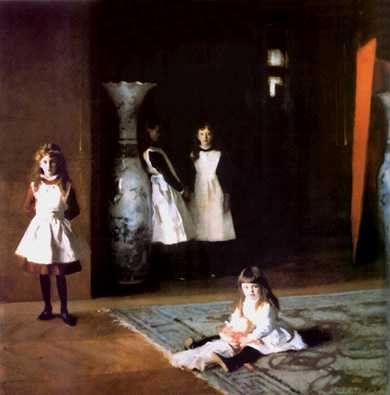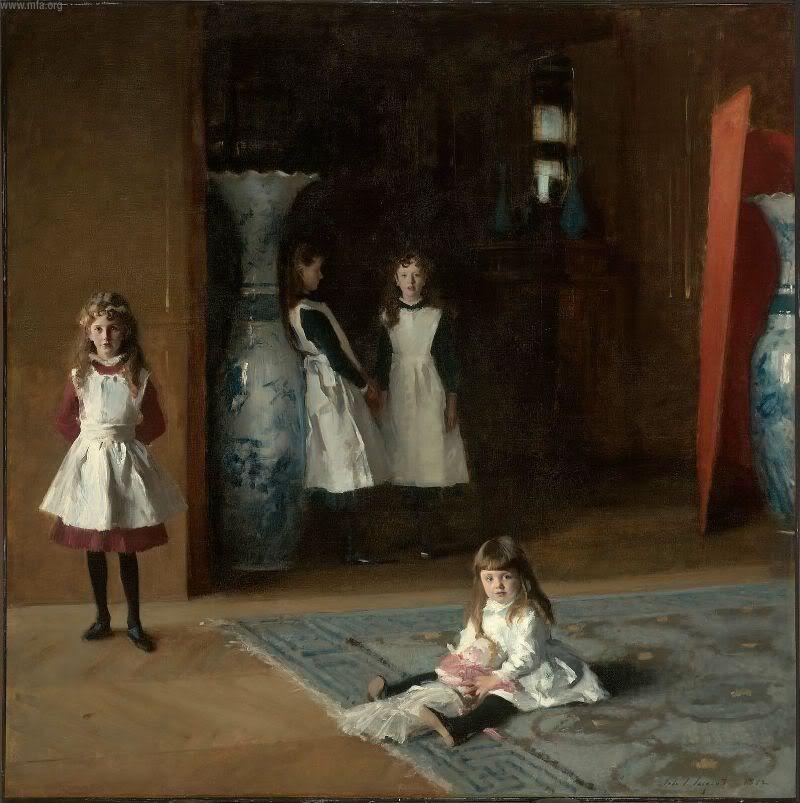Daughters is a portrait of four sisters in their apartment in Paris. The youngest sits on a rug near the bottom center playing with a doll. Her next oldest sibling stands on the left with her hands behind her back. The two eldest daughters stand in the shadows in the center, the second oldest standing facing the viewer as the third oldest, the oldest turned away so we cannot see her face. The oldest is also leaning against a huge vase; its companion stands before a red screen on the right.
The line in this painting seems to follow one girl throughout her adolescence. She is sitting on the rug playing, and the two edges of that rug point to her next stage, which is still obvious but more proper. A wall behind this girl forms another line against with the vase is standing. One’s eye jumps to the red screen which forms two more lines that lead the eye back to the rug.
The two oldest girls appear to be standing in a dark box, but the whole apartment feels closed and confined like a box. This darkness makes one feel sad, depressed to see the confined and restrictive world that the girls live in. The red draws one’s eye to the beautiful things that these girls are surrounded with but are surely not allowed to touch. On the top right there is a bit of undefined light that continues to give the painting depth.
The girls are all dressed in almost exactly the same way, with a pinafore over a dress, black tights, and black shoes. The youngest’s dress and pinafore is blindingly white and undefined, the next oldest is in dark red and slightly rumpled, and the two eldest are in black with pressed pinafores. The vases are pearly grey and black, the rug predominantly a sage green. The floor and wall are a warm golden-toned wood.
The rug itself has texture: it looks a lot like any rug one would see on the living room floor, bristly or soft. The youngest girl’s doll has a dress that is pink and white, made of fluffy and beautiful sheer fabric one expects to see made into a gown for dancing. The wood throughout the apartment looks smooth, the vases smooth and glossy. The pinafores of the three eldest girls all have a sturdy cotton texture to them.
The two vases help draw one’s eye across the room. The rug has a pattern of diamonds set in rings. The floor has a diagonal inlay that points both to the left and the right at the same time. The first thing one’s eye is drawn to is the youngest girl: she is the center of interest. The girls are all in scale with and proportionate to one another, but the vases are both taller than the oldest girl. The eye moves easily around the work and finds balance except in the dark box: it seems to suck one inside if they let it: its dimensions are vague so the negative space seems to go on almost forever if it weren’t for the undefined reflection near the back. Because of the painting’s large size, the girls are probably larger than life size.
In A World of Art Henry James likens this painting to an Alice in Wonderland experience but to me this painting is about growing up. When one is young it is as if they are in the center of the universe. As they age they draw away from others and become less open about their identity. Though a parent doesn’t forget their children they seem to focus more on their younger daughters than their older ones. These girls are also losing innocence as they age and becoming weighted down with the expectations that are placed on them as they mature. None of the girls look happy though they clearly want for nothing… nothing physical anyway. They are provided for but seem emotionally detached. Perhaps the red screen, which brings the eye back to the beginning again, symbolizes how the cycle always continues and life always begins anew but in the same way it did for the generation before us. It is a beautiful painting but kind of depressing, too.
image similar to the one in A World of Art (though smaller)

a better image (that would have influenced my critique had i seen it while i was writing it!)

No comments:
Post a Comment